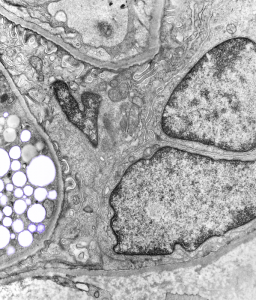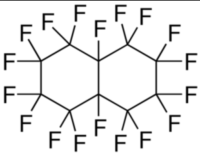 It has been three or more decades since I visited (revisited) the artificial blood research that was done in the Institute for Developmental Research (which is no longer an entity of that name, changed, many iterations ago. But this research was spearheaded by the Late Leland Clark Jr, major inventor in medicine in cincinnati. I took so many tissues, looked at so many images of artificial blood in various animals that when I consider it in retrospect, it is just off the charts. Few really time honored publications came from that scattered search for a good oxygen carrying substitute for real blood, but Clark was determined that in and among the myriad compounds that he would find something great. As an electron microscopist, all I saw was a reticuloendothelial system packed with little white fluorocarbon “footprints”, and a lot of activated macrophages. Here is an interesting image (i dont have the neg and animal numbers off hand) of monkey kidney and on the left you see the remnants of perfluorodecalin (outlined in purple).
It has been three or more decades since I visited (revisited) the artificial blood research that was done in the Institute for Developmental Research (which is no longer an entity of that name, changed, many iterations ago. But this research was spearheaded by the Late Leland Clark Jr, major inventor in medicine in cincinnati. I took so many tissues, looked at so many images of artificial blood in various animals that when I consider it in retrospect, it is just off the charts. Few really time honored publications came from that scattered search for a good oxygen carrying substitute for real blood, but Clark was determined that in and among the myriad compounds that he would find something great. As an electron microscopist, all I saw was a reticuloendothelial system packed with little white fluorocarbon “footprints”, and a lot of activated macrophages. Here is an interesting image (i dont have the neg and animal numbers off hand) of monkey kidney and on the left you see the remnants of perfluorodecalin (outlined in purple).
Here is what wikipedia has to say about PFD, as we tagged on the acronym back in the 1970s.
Medical applications Of all the perfluorocarbons, perfluorodecalin has probably seen the most interest in medical applications. Most applications utilize its ability to dissolve large amounts of oxygen (100 mL of perfluorodecalin at 25 °C can dissolve 49 mL of oxygen at STP). Perfluorodecalin was an ingredient in Fluosol, an artificial blood product developed by Green Cross Corporation in the 1980s. It is also being studied for use in liquid breathing. Perfluorodecalin can be applied topically, to provide extra oxygen to a specific location, to accelerate wound healing. Organs and tissues can be stored for longer in oxygenated perfluorodecalin; the “two-layer method” uses perfluorodecalin and UW s olution to preserve tissue for pancreas transplants.
olution to preserve tissue for pancreas transplants.
nb… green cross developed it maybe, and sunventures, but clark was the main proponent for many years. Here is what PFD looks like